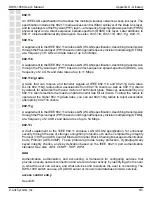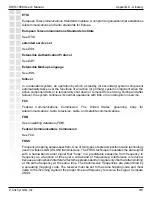
424
DWS-1008 User’s Manual
D-Link Systems, Inc.
Appendix D - Glossary
ISO
International Organization for Standardization. An international organization of national
standards bodies from many countries. ISO has defined a number of computer standards,
including the Open Systems Interconnection (OSI) standardized architecture for network
design.
IV
See
initialization vector (IV)
.
jumbo frame
In an Ethernet network, a frame whose data field exceeds 1500 bytes.
LAWN
See
WLAN
.
LDAP
Lightweight Directory Access Protocol. A protocol defined in RFC 1777 for management
and browser applications that require simple read-write access to an X.500 directory without
incurring the resource requirements of Directory Access Protocol (DAP). Protocol elements are
carried directly over TCP or other transport, bypassing much of the session and presentation
overhead. Many protocol data elements are encoded as ordinary strings, and all protocol
elements are encoded with lightweight basic encoding rules (BER).
Lightweight Directory Access Protocol
See
LDAP
.
location policy
An ordered list of rules that overrides the virtual LAN (VLAN) assignment and security ACL
filtering applied to users during normal authentication, authorization, and accounting (AAA)—
or assigns a VLAN or security ACL to users without these assignments. Defining location
policy rules creates a location policy for local access within a DWS-1008 switch. Each switch
can have only one location policy. See also
location policy rule
.
location policy rule
A rule in the location policy on a DWS-1008 switch that grants or denies a set of network
access rights based on one or more criteria. Location policy rules use a username or VLAN
membership to determine whether to override—or supply—authorization attributes during
authentication and to redirect traffic. Location policy rules are processed in the order in which
they appear in the location policy. See also
location policy
.
MAC
(1) Media access control. See
MAC address
. (2) Message authentication code. A
keyed hash
used to verify message integrity. In a keyed hash, the key and the message are inputs to the
hash algorithm. See also
MIC
.
















































